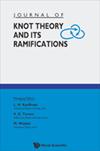最多四个元素的拓扑广数
IF 0.4
4区 数学
Q4 MATHEMATICS
引用次数: 0
摘要
S. Nelson 和 C. Wong 最近定义的有限拓扑阶元可以表示为 $n\times n$ 矩阵。在本文中,我们首先研究了有限拓扑簇,并展示了如何使用这些矩阵来区分给定心度 $n$ 的有限拓扑簇的所有同构类。作为一种应用,我们对最多有 4 个元素的有限拓扑簇进行了分类。本文章由计算机程序翻译,如有差异,请以英文原文为准。
The Topological Quandles up to four Elements
The finite topological quandles can be represented as $n\times n$ matrices, recently defined by S. Nelson and C. Wong. In this paper, we first study the finite topological quandles and we show how to use these matrices to distinguish all isomorphism classes of finite topological quandles for a given cardinality $n$. As an application, we classify finite topological quandles with up to 4 elements.
求助全文
通过发布文献求助,成功后即可免费获取论文全文。
去求助
来源期刊
CiteScore
0.80
自引率
40.00%
发文量
127
审稿时长
4-8 weeks
期刊介绍:
This Journal is intended as a forum for new developments in knot theory, particularly developments that create connections between knot theory and other aspects of mathematics and natural science. Our stance is interdisciplinary due to the nature of the subject. Knot theory as a core mathematical discipline is subject to many forms of generalization (virtual knots and links, higher-dimensional knots, knots and links in other manifolds, non-spherical knots, recursive systems analogous to knotting). Knots live in a wider mathematical framework (classification of three and higher dimensional manifolds, statistical mechanics and quantum theory, quantum groups, combinatorics of Gauss codes, combinatorics, algorithms and computational complexity, category theory and categorification of topological and algebraic structures, algebraic topology, topological quantum field theories).
Papers that will be published include:
-new research in the theory of knots and links, and their applications;
-new research in related fields;
-tutorial and review papers.
With this Journal, we hope to serve well researchers in knot theory and related areas of topology, researchers using knot theory in their work, and scientists interested in becoming informed about current work in the theory of knots and its ramifications.

 求助内容:
求助内容: 应助结果提醒方式:
应助结果提醒方式:


